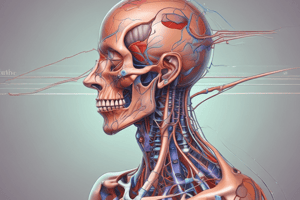Podcast
Questions and Answers
What is the primary function of the shoulder girdle?
What is the primary function of the shoulder girdle?
- To link the upper extremity to the trunk (correct)
- To provide stability to the upper extremity
- To facilitate movement of the spine
- To strengthen the muscles of the upper arm
What is unique about the shoulder girdle in terms of bony constraints?
What is unique about the shoulder girdle in terms of bony constraints?
- It has no bony constraints, relying on soft tissues for stability (correct)
- It has a wide range of motion due to bony constraints
- It has limited motion due to bony constraints
- It has both bony and soft tissue constraints
What is the result of the four joints of the shoulder complex acting together?
What is the result of the four joints of the shoulder complex acting together?
- Mobility greater than that afforded by any one individual articulation (correct)
- Decreased movement of the spine
- Increased stability
- Reduced mobility
In which plane does abduction of the shoulder complex occur?
In which plane does abduction of the shoulder complex occur?
What is the term for rotation about the long axis of the humerus?
What is the term for rotation about the long axis of the humerus?
What type of joint allows for a wide range of motion at the expense of stability?
What type of joint allows for a wide range of motion at the expense of stability?
What is traditionally measured to describe the range of motion of the shoulder complex?
What is traditionally measured to describe the range of motion of the shoulder complex?
What movement of the spine affects the ability of the shoulder complex to position the upper extremity?
What movement of the spine affects the ability of the shoulder complex to position the upper extremity?
Flashcards are hidden until you start studying
Study Notes
The Shoulder Girdle
- The shoulder girdle is the link between the upper extremity and the trunk, enabling hand positioning in space.
- It is the most dynamic and mobile joint in the body, consisting of four articulations: glenohumeral, acromioclavicular, sternoclavicular, and scapulothoracic.
Characteristics of the Shoulder Girdle
- The absence of bony constraints allows for a wide range of motion, but at the expense of stability.
- Stability is provided entirely by soft tissues.
Kinematics and Anatomy
- The four joints work together to produce intricate motions necessary for normal hand positioning in space.
- The shoulder complex's ability to position the upper extremity is also augmented by spinal movement.
Range of Motion of the Shoulder Complex
- Shoulder range of motion is measured in terms of flexion, extension, abduction, and internal-external rotation.
- Forward elevation (flexion) averages 167° in men and 171° in women, limited by tension on the joint capsule.
- Extension (posterior elevation) averages 60°, limited by tension on the joint capsule.
- Abduction in the coronal plane is limited by bony impingement of the greater tuberosity on the acromion.
Studying That Suits You
Use AI to generate personalized quizzes and flashcards to suit your learning preferences.


